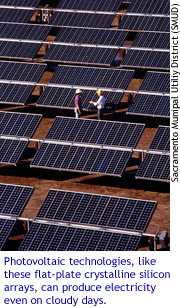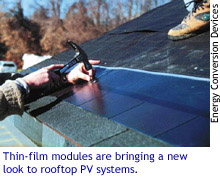|
|
|
|
|
Consumer Guides |
Government Guides |
Consumer News |
Consumer Guides
Index
Consumer Guides
Home
Submit Government Guide
________
Disclaimer
Solar Power PhotovoltaicsSource: U.S. Department of Energy |
|
Knowledge of the sun's ability to produce both heat and electricity has
led to the invention of several technologies for generating electricity
from the sun's energy. These technologies comprise photovoltaic and concentrating
solar power (also known as solar thermal electric) systems.
Photovoltaic (PV) technologies produce electricity directly from sunlight. When sunlight strikes the semiconductor materials out of which PV technologies are made, a portion of that light is absorbed. If the energy from the absorbed light strikes electrons in the outer shell of an atom, these electrons are freed from their parent atoms. Free electrons can then travel into a circuit in the form of electricity. The most common PV device available today is made from rigid, crystalline silicon solar cells (although other materials can also be used). About 40 of these cells are typically combined to produce a flat module, and about 10 of these modules are mounted to form a PV array, which can measure up to several meters on a side. PV arrays can be mounted at a fixed angle facing south, or they can be mounted on a tracking device that follows the sun, allowing them to capture the most sunlight over the course of a day. In addition to PV arrays, flexible sheets of thin-film PV modules, made with various non-crystalline materials, are just now starting to enter the commercial and residential buildings market for use as rooftop shingles. These modules have traditionally been used in consumer electronics.
How Photovoltaics are Used PV systems can be sized to meet both large and small electricity supply applications. An increasing number of power companies are now experimenting with using crystalline silicon PV to meet some of their power needs. Our Buying Clean Electricity section provides information on buying electricity generated from PV and other renewable energy technologies in your state. Where Photovoltaics are Used Knowledge of the sun's ability to produce both heat and electricity has led to the invention of several technologies for generating electricity from the sun's energy. These technologies comprise photovoltaic and concentrating solar power (also known as solar thermal electric) systems. How Concentrating Solar Power Technologies Work Parabolic-trough systems concentrate the sun's energy through long rectangular, curved (U-shaped) reflectors. The reflectors are tilted toward the sun, focusing the sun's energy on a pipe that runs down the center (focal point) of the trough. This heats oil flowing through the pipe. The hot oil then is used to boil water in a conventional steam generator to produce electricity. A power tower system uses a large field of reflectors to concentrate the sun's energy onto the top of a tower, where it heats a receiver filled with a heat-exchange fluid, such as oil. The heated fluid is then used to generate electricity in a conventional steam generator. Systems using molten salt as the heat-exchange fluid retain heat very efficiently, enabling them to produce electricity up to three hours after the sun has set. How Concentrating Solar Power Technologies are Used Troughs have a proven track record as a technology that can function effectively for large-scale power needs (such as those of a power company), and are currently the least expensive way to produce solar electricity. Our Buying Clean Electricity section provides information on buying electricity generated using CSP and other renewable energy technologies in your state. Power towers have also demonstrated their efficiency in demonstration projects, although they are not yet in use commercially. Where Concentrating Solar Power Technologies are
Used
|
|
|
Hot Link:
iTunes Gospel Rock Music
![]()
Rock version of
the Lord's Prayer
and more...
Presence
a unique find...
www.mycrossbridge.org



 The
performance of a PV technology is measured in terms of its efficiency at
turning sunlight into electricity. Only sunlight of certain wavelengths
will work efficiently to create electricity, and much of it is reflected
or absorbed by the materials that make up the cell. Researchers are
working to improve PV module efficiencies while holding down the cost.
The
performance of a PV technology is measured in terms of its efficiency at
turning sunlight into electricity. Only sunlight of certain wavelengths
will work efficiently to create electricity, and much of it is reflected
or absorbed by the materials that make up the cell. Researchers are
working to improve PV module efficiencies while holding down the cost.